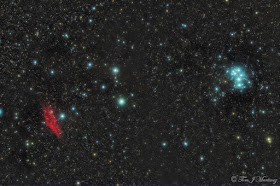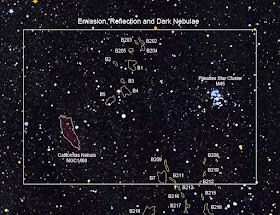 Click on image for a larger view
Click on image for a larger view What to do, what to do? My imaging equipment is all set up for the night, but here comes the clouds. High cirrus are sailing across what was a clear and cloudless sky while I was setting up. I really want to try out my new lens on the sky, so I decide to try a few shots anyway. I take six shots, ten minutes each. By the time the last exposure is done, the sky is pretty well covered with clouds. As they come into my laptop I see that each image has halos around each star, with the last image having the largest halos. As I shut down the computer, I'm thinking that will be the last see of those pictures.
What to do, what to do? My imaging equipment is all set up for the night, but here comes the clouds. High cirrus are sailing across what was a clear and cloudless sky while I was setting up. I really want to try out my new lens on the sky, so I decide to try a few shots anyway. I take six shots, ten minutes each. By the time the last exposure is done, the sky is pretty well covered with clouds. As they come into my laptop I see that each image has halos around each star, with the last image having the largest halos. As I shut down the computer, I'm thinking that will be the last see of those pictures.***
That was two months ago. Today I saw an image by Rogelio Bernal Andreo on the Astronomy Picture of the Day website that had practically the same framing and image scale of what I took that night. My my, what a picture it is. Here is the link to his picture: http://tinyurl.com/yj3txu2 After seeing this I decided to process my images to see what I had (a single image doesn't show much, only when they are aligned, combined and processed does the detail come out). My picture doesn't go as deep as Mr. Adnreo, for a lot of reasons, but I am happy the way it came out. The glow around the stars give the picture a mystical quality, and the Califonia Nebula and the Plieades Star Cluster still show through. The dusty dark nebulae throughout this part of the sky is also evident. The dark nebulae are labeled in the second image above, but as you can see, they are actually spread all over the area.
***
Technical Photo Info
Camera: Q454 CCD
Lens: Canon 70-200mm f/2.8 L IS
Focal Length Setting: 70mm
Apeture Setting: f/4
Exposures: 6 X 10 minutes
Darks: 2 darks to create a dark pixel map
Flats: 0
Biases: 0
Mount: Celestron CGE
Guide Camera: CCD-Labs Q-Guider
Guidscope: 400mm Tasco refractor
Calibrated, Aligned and Stacked in Nebulosity
Final processing in Photoshop

No comments:
Post a Comment